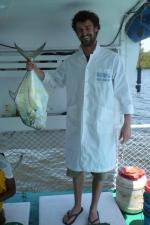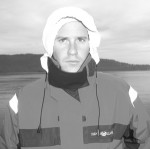 Myriam was born and grew up in Tunisia. After high school she studied for two years at the higher institute of preparatory studies in Biology and Geology (ISEP-BG) and was then accepted to the National Agronomic Institute of Tunisia (INAT) where she completed her engineering degree in fisheries and environment. In 2013, Myriam joined The Sea Around Us project to begin working on the catch reconstructions of certain Mediterranean and Arab countries. She is currently working on her master’s degree in fisheries under the supervision of Dr. Daniel Pauly.
Myriam was born and grew up in Tunisia. After high school she studied for two years at the higher institute of preparatory studies in Biology and Geology (ISEP-BG) and was then accepted to the National Agronomic Institute of Tunisia (INAT) where she completed her engineering degree in fisheries and environment. In 2013, Myriam joined The Sea Around Us project to begin working on the catch reconstructions of certain Mediterranean and Arab countries. She is currently working on her master’s degree in fisheries under the supervision of Dr. Daniel Pauly.
Category: Students
Mathieu Colleter – Post-Doc
I was born in Burgundy, France and grew up in Lyon, neither of which are really sea-related places. However, many of my childhood holidays were spent near the water at my grandparents’ home in Paimpol, on the North coast of Brittany. Fishing crabs at low tide, playing on shingle beaches, and walking along the coast were great occupations for young city boy! I was stunned as an adolescent to realize the decline of crabs and abalones available, compared to harvests I recall as a child with my grandmother. I also discovered scuba diving at age 13, and started diving with my family all around the world. This set me on the track to follow the passions of my youth, and study marine ecology and fishery sciences.
After my ‘baccalaureat’ (which marked the end of high-school), I studied for entrance into the French Grandes Ecoles during two years in ‘Classes préparatoires’. I entered Agrocampus Ouest (Rennes, France) and completed an agronomy engineer diploma specializing in fishery sciences and aquaculture in 2010. During my degree, I also did an internship at the Macquarie University (Sydney, Australia) under the supervision of Dr. Culum Brown to study the behavior of the rainbowfish. We examined behavioural traits and their link with the establishment of the hierarchy in male rainbowfishes. I completed my MSc thesis working with Drs. Didier Gascuel (Agrocampus Ouest) and Luis Tito De Morais (IRD). My research assessed the potential effects of a marine protected area (MPA), the Bolong de Bamboung, in the Sine Saloum estuary (Senegal). We used ecosystem modelling approaches (Ecopath and EcoTroph) to investigate the impact of the MPA enforcement between 2003 (last fished year) and 2006-2008 (three years after the closure of the fishery).
As a PhD Candidate, I am working with Dr. Daniel Pauly at the UBC Fisheries Centre, and with Dr. Didier Gascuel at Agrocampus Ouest thanks to a joint PhD agreement. My proposed research has been developed to address concerns about the potential impacts of fisheries on underlying trophic functioning at a global scale. The aim of this study is to better understand the trophic functioning and its variability throughout ecosystems. We propose to use two well-known trophodynamic models: Ecopath with Ecosim (EwE) and EcoTroph (ET). New insights into trophic functioning could be obtained from a large meta-analysis of the hundreds of EwE models developed since the end of the 1980s. Additionally, EcoTroph is a recently developed model incorporated as a plug-in of EwE that enables the comparative analysis of Ecopath models through a uniform framework, the trophic spectrum. Using these two tools, we propose to conduct a meta-analysis of the marine ecosystems trophic functioning and the related impacts of fisheries at a global scale. We will then develop a dynamic mapping of the fishing impact on ocean biomass and its trophic distribution.
Selected Publications
Colléter, M., Brown, C., 2011. Personality traits predict hierarchy rank in male rainbowfish social groups. Animal Behaviour 81, 1231–1237.
Colléter, M., Gascuel, D., Ecoutin, J.-M., Tito de Morais, L., 2012. Modelling trophic flows in ecosystems to assess the efficiency of marine protected area (MPA), a case study on the coast of Sénégal. Ecological Modelling 232, 1–13.
Colléter, M., Guitton, J., Gascuel, D., 2012. An EcoTroph modelling package for R [WWW Document]. EcoTroph Website, http://sirs.agrocampus-ouest.fr/EcoTroph/.
Colléter, M., Guitton, J., Gascuel, D., Accepted. An Introduction to the EcoTroph R Package: Analyzing Aquatic Ecosystem Trophic Network. R Journal.
Dyhia Belhabib – Post-Doctoral Research Fellow
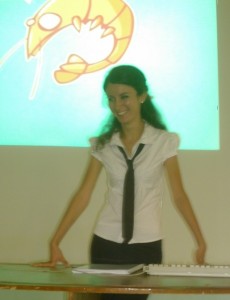 Dyhia Belhabib is currently a Post-Doctoral Research Fellow with the Sea Around Us (UBC). As the Africa Lead of the Sea Around Us, she reconstructs catch and effort time series for countries of Africa, where quantitative data are severely lacking, using a different range of innovative approaches. She engages directly with different local and regional groups for the use of fisheries data, and the development of policy and management plans. Dyhia is collaborating with several organizations and experts on different research fronts including the impacts of fisheries on local economies, the footprint of armed conflicts and natural disasters on global fisheries, and with NGOs, analyzing the impacts of development projects on fisher’s communities in Senegal, the footprint of illegal fishing and piracy in Somali waters. Dyhia also holds an advisory position on the scientific board of the Research and Development Division of the Ministry of Fisheries and Aquaculture in Algeria.
Dyhia Belhabib is currently a Post-Doctoral Research Fellow with the Sea Around Us (UBC). As the Africa Lead of the Sea Around Us, she reconstructs catch and effort time series for countries of Africa, where quantitative data are severely lacking, using a different range of innovative approaches. She engages directly with different local and regional groups for the use of fisheries data, and the development of policy and management plans. Dyhia is collaborating with several organizations and experts on different research fronts including the impacts of fisheries on local economies, the footprint of armed conflicts and natural disasters on global fisheries, and with NGOs, analyzing the impacts of development projects on fisher’s communities in Senegal, the footprint of illegal fishing and piracy in Somali waters. Dyhia also holds an advisory position on the scientific board of the Research and Development Division of the Ministry of Fisheries and Aquaculture in Algeria.
Krista Greer – Research Assistant
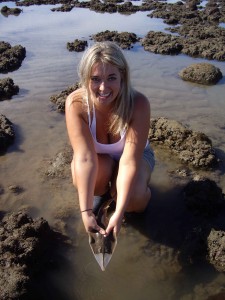 Krista is a from a small town in Ontario, Canada. While her initial undergraduate focus was Biological Anthropology, she found that her long-time interests in marine conservation could not be suppressed. As such, she went on to study Marine Biology and Zoology at James Cook University in Australia. Throughout her undergraduate years, Krista had the opportunity to participate in field work all over the world including Costa Rica, Kenya, Seychelles and Borneo. In September 2011, she arrived at the University of British Columbia to do her Masters under the supervision of Dr. Daniel Pauly. Her thesis focused on the carbon emissions of the world’s fishing fleets since 1950 and what the “true” cost of fishing is when its environmental impacts are adequately considered. She now works as a research assistant on fishing effort and CO2 databases.
Krista is a from a small town in Ontario, Canada. While her initial undergraduate focus was Biological Anthropology, she found that her long-time interests in marine conservation could not be suppressed. As such, she went on to study Marine Biology and Zoology at James Cook University in Australia. Throughout her undergraduate years, Krista had the opportunity to participate in field work all over the world including Costa Rica, Kenya, Seychelles and Borneo. In September 2011, she arrived at the University of British Columbia to do her Masters under the supervision of Dr. Daniel Pauly. Her thesis focused on the carbon emissions of the world’s fishing fleets since 1950 and what the “true” cost of fishing is when its environmental impacts are adequately considered. She now works as a research assistant on fishing effort and CO2 databases.
Outside of her research, Krista loves to read and participate in outdoor activities. In particular she enjoys scuba diving, camping, beach walking and spending time with her dog, Nelly.
Dalal Al-Abdulrazzak – Ph.D. Student
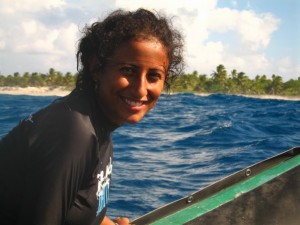 Dalal has always had an affinity for the ocean. Born and raised in Kuwait, she spent her youth exploring the coral reefs, mudflats and sea grass beds of the Persian Gulf. In 1991 she witnessed first hand the devastating effects of war on the local environment and vowed to do everything she could to restore it.
Dalal has always had an affinity for the ocean. Born and raised in Kuwait, she spent her youth exploring the coral reefs, mudflats and sea grass beds of the Persian Gulf. In 1991 she witnessed first hand the devastating effects of war on the local environment and vowed to do everything she could to restore it.
After graduating with BA in Environmental Studies from Middlebury College, VT, Dalal received a Watson Fellowship to travel to Panama, the Bahamas, New Zealand, Fiji, Palau, the Seychelles and South Africa to research the extent to which cultural context influences elasmobranch conservation efforts. Armed with nothing but a 5kg backpack and 20kg of SCUBA gear, she spent a year backpacking solo, logging over 200+ dives, and coming face to face with bull sharks, tiger sharks, great whites, and giant mantas. During this time, she also slept on 66 different beds, ate 9 jars of peanut butter and took 5, 538 photos.
She briefly returned to the “real world,” working as a research assistant to Dr. Jeremy Jackson at the Scripps Institution of Oceanography, where she investigated the environmental and economic effects of the “rats and cockroaches” of the ocean, (i.e. the invasive species that will become permanent components of ecosystems).
Dalal comes to the Sea Around Us to work under the supervision of Dr. Daniel Pauly. Her research interests lie in the historical marine ecology of the Persian Gulf. Through a variety of historical documents she hopes to assess and quantify changes in the distribution and abundance of marine species in the Gulf, in order to establish more accurate baselines from which to measure changes. Her main goal is to understand the relationship between social history and changing marine environments in hopes of more successfully managing marine resources.
Lucas Brotz – Ph.D. Student
Profile
BSc (Astrophysics); MSc (Oceanography); currently enrolled in PhD (Zoology)
Research Interests
Jellyfish populations are increasing in numerous ecosystems around the globe. Not surprisingly, these increases are not uniform across time and space. So why are jellyfish increasing in some places and not others? What are the consequences for humans and ecosystems? And what, if anything, can we do to manage or prevent increasing jellyfish blooms?
Jellyfish population dynamics are complex, partly because of the unique life cycles of many species. Jellyfish may exist as pulsing medusae, sessile polyps, or cysts capable of resisting harsh environmental conditions. Reproductive strategies include sexual and asexual reproduction, as well as hermaphroditism. As such, jellyfish populations are influenced by a variety of anthropogenic and environmental factors at different, often cryptic, life stages.
Increasing jellyfish populations can impact humans in both negative and positive ways. Industries such as tourism, aquaculture, fishing, power generation, desalination, and shipping have all reported considerable economic losses due to jellyfish blooms. In contrast, fisheries that harvest jellyfish for food are expanding around the globe, and jellyfish are now a popular draw for public aquaria. As both human and jellyfish populations increase, new interactions are sure to emerge, as jellyfish get in our way and as we find new ways to exploit them.
Ironically, it appears that in some cases, humans may be responsible for the observed increases in jellyfish populations. While there is no single cause of increasing jellyfish populations, there is evidence that fishing, pollution, aquaculture, shipping, global warming, and coastal development can all create conditions that favour jellyfish over fish. Most of these links are only correlative, but the rise of jellyfish in coastal ecosystems worldwide should be cause for concern. We may need to decide now whether or not we want our children to be eating jellyfish burgers. If our behaviour doesn’t change, they might not have a choice.
Publications
Gregr, E.J., R. Gryba, M.C. James, L. Brotz, & S.J. Thornton (in revision). Information relevant to the identification of critical habitat for Leatherback Sea Turtles (Dermochelys coriacea) in Pacific Canadian waters. DFO Canadian Science Advisory Secretariat Research Document.
Brotz, L. & D. Pauly (in press). Jellyfish populations in the Mediterranean Sea. Acta Adriatica.
Brotz, L. (2012) Of leatherbacks and lion’s manes. Sea Around Us Project Newsletter (71): 1-4.
Brotz, L. (2012). Learning about Pacific leatherback sea turtles by examining jellyfish. Report prepared for Fisheries and Oceans Canada, 29 pp.
Brotz, L., M. Lebrato, K.L. Robinson, M. Sexton, A. Sweetman, K. Pitt, & R. Condon (2011) Implications of increased carbon supply for the global expansion of jellyfish blooms.Limnology & Oceanography Bulletin (20): 38-39.
Brotz, L. (2011) Are jellyfish the food of the future? INFOFISH International (4): 60-63.
Brotz, L. (2010) Gelatinous Seas. Discovery, Nature Vancouver (39): 14-20.
Brotz, L. (2010) What’s for dinner? Sea Around Us Project Newsletter (57): 4-5.
Media Coverage
Jellyfish Invasion, Costing the Earth, BBC Radio, May 22, 2012.
Rise of the jellies, Quirks & Quarks, CBC Radio, April 28, 2012.
Jellyfish numbers soar worldwide. CTV News Channel, April 21, 2012.
Jellyfish populations booming, CBC News, April 20, 2012.
Menace from the ocean deep. National Post, April 19 2012 (front page).
Jellyfish swarm coastal waters. Vancouver Sun, April 19, 2012 (front page).
Interview, As It Happens, CBC Radio, April 19, 2012.
Attack of the blobs. Nature (482): 20-21, February 2, 2012.
Growing jellyfish invasion oozes across southern U.S. The Toronto Star, September 20, 2011.
Jellyfish Swarms: Menacing or Misunderstood? LiveScience, October 20, 2010.
Interview – Fisheries Broadcast, CBC Radio Newfoundland, August 20, 2010.
Tofu of the Sea. Edible Vancouver (12): 18-19, Summer 2010.
Invasion of the Holiday Snatchers. The Economist.com, March 28, 2008.


